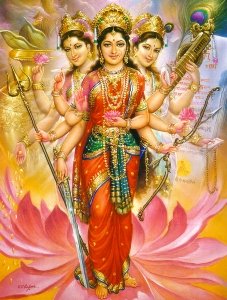Essence Of Devi Bhagavatha Purana |
|
 |
Bhakti and Punya Kshetras ( Holy Places of Pilgrimage) Having explained Brahma Gyan, Devi Bhagavathi provided alternative routes of realising Her viz. Bhakti Yoga, Karma Yoga and Jnana Yoga. Of these the Bhakti Marg is the simplest as it involves the least pain of the body and enables facile concentration on the target. However, this too could inflict bodily hurt if it aims doing adverse reactions against others in a typical Tamasic manner. |
If a rajasic kind of Bhakti is the objective to fulfil one’s own desires, there is nothing unnatural about it. But the pure Satvik kind of ‘Nishkama (selfless) Bhakti’ is indeed the ideal as it gives an instant equation with the Object. In fact it leads to ‘Para Bhakti’ or highest form of dispassionate Devotion which has the pure feeling of ‘Sevya’ and ‘Sevaka’( Master and Servant) without even targetting Salvation. That kind of devotion is contented with whatever ‘Prarabdha’ has decided for the devotee and despite that there is no other feeling excepting the intoxication of pure love without strings, which is similar to ‘Jnana Yoga’. This extreme devotion, as Devi Bhagavati defines, is on the analogy of gold converted as an ornament or Bhakti in peak position tends to turn into ‘Brahmatva’ itself! Among the ways of such Supreme Bhakti, Maha Devi cited Prayers, ‘Japas’ ( repetitive recitation of Devi’s various manifestations), Group chantings of Devi’s glories (Bhajans), hearing of Puranas, Mantras, Hymns and music-dance performances, observing fasts, executing ‘Vraths’ ( functions related to pujas of specific manifestation of Devi and so on). One another manner of Bhakti is to visit places of Pilgrimage or ‘Thirtha Yatras’ As ‘Bharat Varsha’abounds Temples and Holy Rivers all across its length and breadth, Maha Devi mentioned a few illustrative names, but when one’s heart is clean, each and every place of the ‘Karma Bhumi’ is a holy place of worship. Kolhapura on the banks of River ‘Panchaganga’ (in Maharashtra) is Maha Lashmi’s famous Temple situated. The Deity is also known as ‘Karaveera Nivasini Ambabai’ and the City is known as Dakshina Kasi and a Shakti Peetha too. Matripura in Sahyadri mountains or Western Ghats ( Mahur or Mahugadh in Maharashtra) is a Shakti Peetha, the seat of Renuka Devi and also the birth place of Dattatreya. Tuljapura is the abode of Tulja Bhavani (again in Maharashtra and a Shakti Peetha) and next to it Saptashringa with the Temples of Hingula and Jwalamukhi.The Temples of Sakambhari ( Vaishno Devi and on Indrakeeladri -Vijayawada- in Andhra Pradesh), Bhramari (Hill top at Kasauni Town, near Almora, Uttrakhand), Sri Rakta Dandika ( Arunachal Pradesh and Rakteswari near Kateel , Mangalore) and Durga (Varanasi and Kanaka Durga Temple at Vijayawada); Vindhyachala Vasini (Central India), Annapurna ( Benares), Bhima Devi ( Vaishno Devi), Vimala Devi ( Puri), Chandrala Devi, Kausika Devi at Kausika River ( Kosi River), Nilamba ( on top of Nilaparvata) ; Guhya Kali (Nepal), Meenakshi ( Madurai), Sundari at Vedaranya ( Tamilnadu), Ekambaram ( Kanchi), Bhuvaneswara near Purushottama Kshetra as Parasakti; Mahalasa in South at Mallari, Yogeswari Varat, Bagala at Vaidyanath, Manidwipa as Bhuvaneswari, Yoni Mandala Kamakhya at North East ( Gauhati in Assam), Pushkara as Gayatri, Chandika in Amaresa, Pushkarekshini at Prabhasa (Gujarat), Linga Dharini at Naimisharanya, Puruhuta in Puksharaksha, Rati at Asadhi, Dandini at Chamundi, Bhuti in Bharabhuti, Nakuleswari at Nakula, Chandrika in Harischandra, Trisula in Japeswara, Sukshma in Amritakeswara, Shankari in Ujjain, Sarvani in Madhyama, Margadayani in Kedara Kshetra, Mangal at Gayakshetra, Sthanupriya at Kurukshetra, Swayambhu at Nakula, Ugra in Kankal, Mahananda at Attahasa, Bhimeswari at Bhima, Bhairavi at Bhairava, Bhavani Sankari at Vastra Padma, Rudrani in Artha Koti, Visalakshi at Avimukta, Bhadrakarni at Gokarna, Bhadra at Bhadrakarnak, Utpalakshi at Suvarnaksha, Sthanivisa at Sthanu, Kamala at Kamalalaya, Muksewari at Makota, Kali in Kalanjara, Dhvani in Sankhukarna, Sthula in Sthulakeswara, and finally Parameswari Hrilleka in the lotus hearts of Jnanis. Recitation of the above names of Devi in the presence of Brahmanas during ‘Shraddha’ days especially, ‘Pithru Devatas’ would be pleased to bless. There are certain ‘Vratas’( vows) to be performed by men and women, stated Maha Devi to Himavanta, as She would be enormously delighted. Some illustrations are ‘Ananthatritiyaka Vrata, ‘Rasakalyani’ Vrata, ‘Ardrananda’ Vrata, to be performed on ‘Trithiya’or the Third of Hindu Calendar. On a Krishna ‘Chaturdasi’ ie. the fourth day after the moon fall, every Friday and Tuesday too, one might observe fasting till the twilight time of the evenings and perform worship to Devi Bhagavati and terminate fasting. Two Navaratras every Spring and Autumn ie in Vasanta and Dassera seasons daily fasting and worshipping by the dusk time be observed similarly.On the third day of Sukla Chaitra the ‘Dol’ Festival is of significance and ‘Sayanotsav’ of Ashadha Purnamasi too.The ‘Jagaranotsav’ of Kartik Purnamasi Masa, ‘Rathotsava’ of the third of Sukla Ashadha, the ‘Damanotsav’ every Chaitra and all the austerities of Kartika are all dear to Devi Bhagavati. In all these Vratas, puja of virgin Kumaris as though the devotees worship Devi Herself would gladden Her. |
|
| Devi Bhagavata Purana Home |
Back to the News Page